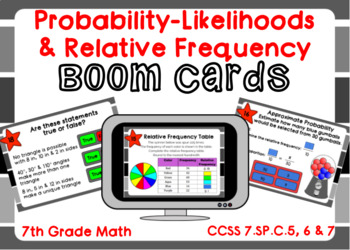Probability-Likelihoods & Relative Frequency Boom Cards-Digital Task Cards
- Google Slides™
- Internet Activities

Description
This card set offers scaffolding for classifying the likelihood of events and determining the relative frequency. Students also use the relative frequency to approximate larger outcomes.
20 Questions:
Classify likelihoods with decimals, percents, and scenarios
Match spinners and gumball machines to their likelihoods
Determine relative frequency using decimals and percents
Use relative frequency to approximate larger outcomes
Boom Card Digital Task Cards allow students to check their answers or get help if needed. Boom Cards are self-grading and no prep!
You may be eligible for a free trial from Boom Learning. Read here for details: http://bit.ly/BoomTrial. If you choose not to stay on a premium account after your free trial, you will still be able to assign all your Boom Cards to as many students as you see fit using Fast Play pins (which give instant feedback for decks that are self-grading). You will not be charged when your free trial expires.





